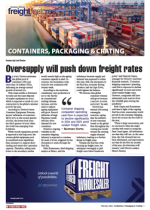By 2027, Drewry estimates the global pool of containers will total more than 56 million TEUs, indicating an average annual growth of around 3%.This comes amidst a downturn in trade and the mass disposal of surplus equipment in 2023, which is expected to result in a 2% contraction in the global container pool for the year.According to Drewry's latest Container Equipment Forecast, lessors' utilisation of containers fell by 97% in the second quarter of 2023, the lowest level since the third quarter of 2020 when the world was emerging from lockdown.While overall equipment growth is expected in the long term, the current global equipment pool is considered more significant than necessary to support short trading and vessel slots' operation capacity. Therefore, selling used boxes to the secondary market would remain high as the ageing container capacity is shed. In contrast, the immediate order book for new containers will remain weak.According to the maritime consultancy, new production is set to rise shortly as containerised trading volumes increase, and the need to replace ageing equipment will grow. Record deliveries of large Panamax vessels will also drive demand for new containers.However, ongoing volatility in the container shipping industry is expected to continue for most of 2024, triggered by the disruption to trade through the Red Sea.Niels Rasmussen, chief shipping analyst at Bimco, said the imbalance between supply and demand was expected to widen this year. Still, the disruption in the Red Sea, currently forcing vessels to sail via Cape Town, could tighten the balance."We forecast that global container volumes will grow between 3 and 4% in 2024 and 2025," he said.Drewry has warned of looming oversupply concerns, saying that the addition of new container vessels to the global f leet throughout the coming year would worsen the existing supply-demand imbalance, leading to a further slump in freight rates."Despite the Red Sea crisis buoying up freight rates, we anticipate oversupply to pull freight rates below breakeven point," said Santosh Gupta, manager for Drewry's maritime financial research. "Container shipping companies' operating cash f low is expected to decline significantly in 2024 and 2025 amid weaker freight rates. However, companies still have substantial cash reserves from the windfall gains during the pa ndem ic ."Both Gupta and Rasmussen said that in light of the ongoing Red Sea crisis, uncertainty would prevail in the container shipping sector for at least the first half of the year."There is huge uncertainty, and no one knows when the major carriers will return to using the Suez Canal again. All indications are that they will not. At the same time, the risk of attack has not been eliminated, and expectations are that for the first six months of the year, the diversions will remain," said Drewry analyst Simon Heaney.

